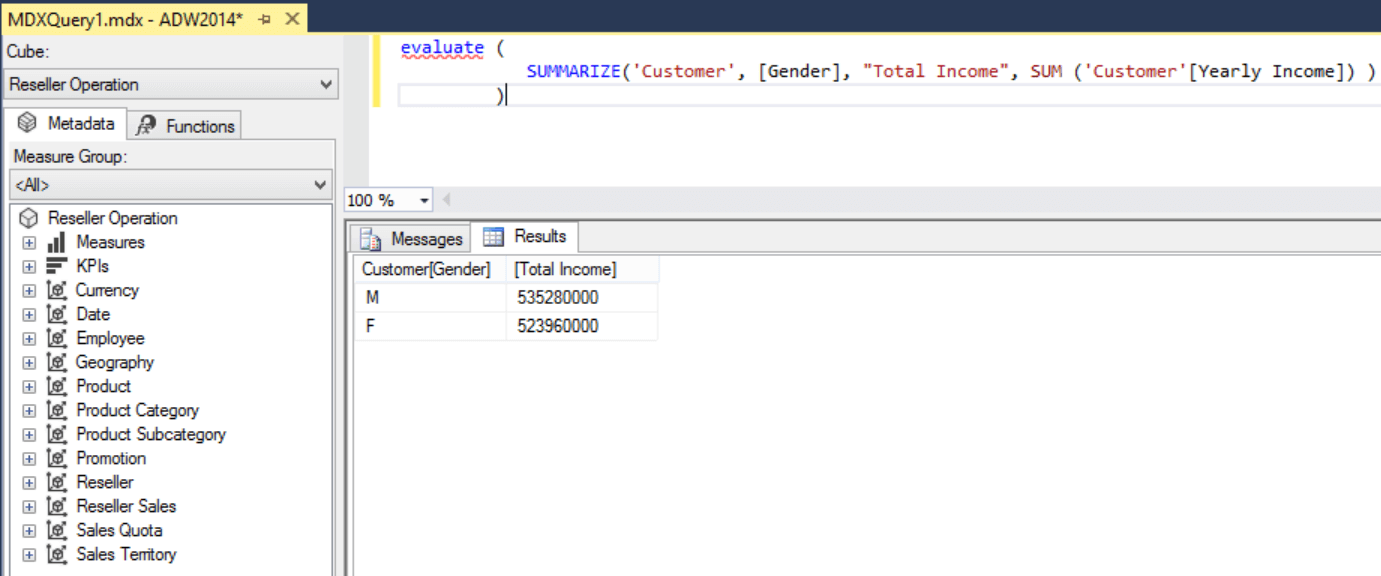


'Education Subtotal',ISSUBTOTAL(DimCustomer), 'Gender Subtotal',ISSUBTOTAL(DimCustomer), The expression below has three columns to check is this subtotal of Gender, Eduction or combination of both Summarize - with IsSubtotal = There is a function named IsSubTotal, which returns True or False saying that is this row a subtotal row or not. Let’s say you want to calculate a percentage, and you want to do that only for rows that are not subtotal. Sometimes, you need to check in the result set, and see if this is a subtotal row or not. ROLLUP(ROLLUPGROUP(DimCustomer,DimCustomer)),Ĭhecking if the Row is a SubTotal Row? IsSubTotal In the expression below, you can see that the RollUpGroup is used inside the RollUp function Summarize - with Rollup and Group = This will lead the removal of subtotal values, and only showing the totals. One of the main usages of RollUpGroup, is to combine it with RollUp, and use it as a parameter inside the RollUp function. Preventing Subtotals: Combining RollUp and RollUpGroup So, you can use either RollUp or RollUp Group to get totals and subtotals. if we replace the RollUp with RollUpGroup in the previous expression, we get exactly the same result Summarize - with Two RollupGroups = RollUpGroup can be used similarly to RollUp for bringing the totals and sub-totals into the aggregated results. This means that after doing all the grouping, roll up on EnglishEduction first, but with the grouping on Gender (highlighted green below with the number 1), and then roll up on Gender (highlighted yellow below with the number 2) Ĭhanging the order of using columns inside RollUp will change the result of roll-up columns. Similar to a matrix way of grouping, if you have more columns inside the RollUp, Rolling up values (or total calculation let’s say) is going through them one by one in the order in which they are written inside the RollUp function.
Dax summarize plus#
The RollUp comes in the place that the grouping column should be, and it means the grouped results, PLUS the total. The above expression, not only create the aggregated result per each Gender, but it also will have one extra ROW in the table for the totals (all genders) Let’s say, you are also interested to see the totals of categories in addition to all other results we had so far, this can be achieved using a RollUp function. You can, however, using Summarize to add more options to your output table. That usage is similar to using the GroupBy function. So far, what you have seen was the usage of Summarize in a simple way with only grouping columns and aggregations. Summarize with RollUp: Totals in the Table Just add the name of each column and the aggregation expression. You can have more than one aggregation if you want too. The result is the count of customers for each EnglishEducation and Gender as below And the aggregation is the count of customers in each group. In the expression above, the grouping columns are EnglishEducation and Gender. And remember that you can also have more than one grouping column Summarize - with aggregation = Now, let’s take it one step further, and use it for aggregation. The expression generates the below result The simplest way of using Summarize function is using it for only grouping, which will give us the unique list of values of a grouping column (similar to what you can achieve with DISTINCT, or VALUES functions) Summarize - Just Group = let’s go through some examples, and you’ll see examples of that. The definition of Summarize function as above looks very similar to GroupBy. Summarize function returns a table as the output. expression the expression to generate the aggregated column.name the name of the new aggregated column.grouping column the name of the column you want to use for grouping.Table a DAX expression that returns a table, or just one of the tables in your dataset.Summarize is a DAX function that gives you an aggregated result from a table, this is how you can use Summarize function: My sample dataset table is DimCustomer as below Creating aggregated tables using DAX functions is particularly very useful when creating virtual tables inside DAX measures.
Dax summarize how to#
Summarize function gives you more control on how to create your aggregated table with some extra functions. In this article, I’ll explain how you can use Summarize function for the same purpose. In the previous article, I explained how you can use GROUPBY function in DAX to create an aggregated table.


 0 kommentar(er)
0 kommentar(er)
